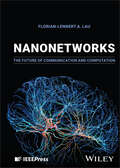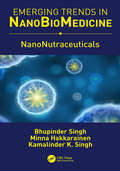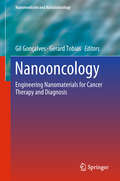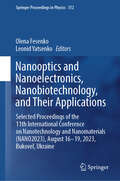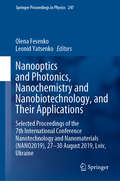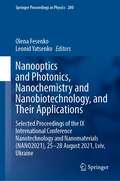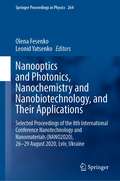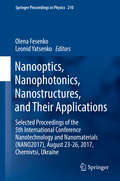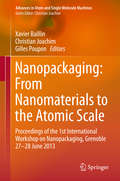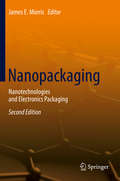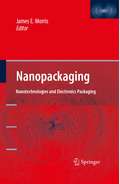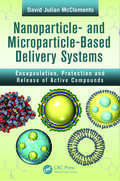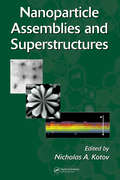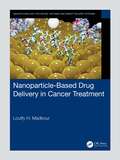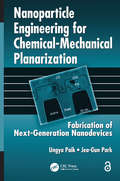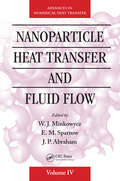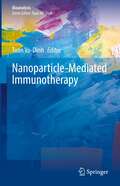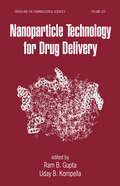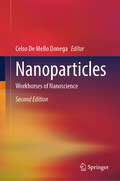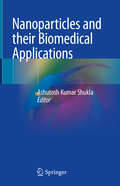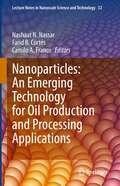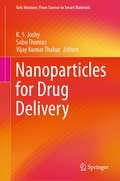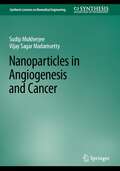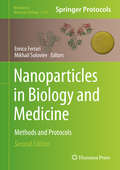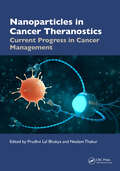- Table View
- List View
Nanonetworks: The Future of Communication and Computation
by Florian-Lennert A. LauLearn the basics—and more—of nanoscale computation and communication in this emerging and interdisciplinary field The field of nanoscale computation and communications systems is a thriving and interdisciplinary research area which has made enormous strides in recent years. A working knowledge of nanonetworks, their conceptual foundations, and their applications is an essential tool for the next generation of scientists and network engineers. Nanonetworks: The Future of Communication and Computation offers a thorough, accessible overview of this subject rooted in extensive research and teaching experience. Offering a concise and intelligible introduction to the key paradigms of nanoscale computation and communications, it promises to become a cornerstone of education in these fast-growing areas. Readers will also find: Detailed treatment of topics including network paradigms, machine learning, safety and securityCoverage of the history, applications, and important theories of nanonetworks researchExamples and use-cases for all formulas and equations Nanonetworks is ideal for advanced undergraduate and graduate students in engineering and science, as well as practicing professionals looking for an introductory book to help them understand the foundations of nanonetwork systems.
NanoNutraceuticals
by Bhupinder SinghThis book will be a comprehensive account of the various facets of nutraceuticals domain. The peruser of this book will find details on various nanotech approaches to nutraceuticals, prebiotics and probiotics, along with their specific applications.
Nanooncology: Engineering nanomaterials for cancer therapy and diagnosis (Nanomedicine and Nanotoxicology)
by Gil Gonçalves Gerard TobiasThis book presents a systematic overview of the most relevant nanomaterials and their respective intrinsic properties that have been highly explored by the scientific community and pharmaceutical companies in several different modalities for cancer therapy and bioimaging. The chapters explore the synergistic effects provided by the different nanostructured materials and highlight the main in vitro and in vivo therapeutic achievements on cancer. This work also provides relevant discussion about the recent progresses and future challenges that nanotechnology faces on the conception of more efficient nanoformulations against primary tumors, circulating cancer cells and metastases.
Nanooptics and Nanoelectronics, Nanobiotechnology, and Their Applications: Selected Proceedings of the 11th International Conference on Nanotechnology and Nanomaterials (NANO2023), August 16-19, 2023, Bukovel, Ukraine (Springer Proceedings in Physics #312)
by Olena Fesenko Leonid YatsenkoThis book highlights some of the latest advances in nanotechnology and nanomaterials from leading researchers in Ukraine, Europe, and beyond. It features contributions from participants of the 11th International Conference Nanotechnology and Nanomaterials (NANO-2023) in Bukovel, Ukraine on August 16-19, 2023 organized by the Institute of Physics of the National Academy of Sciences of Ukraine, University of Tartu (Estonia), University of Turin (Italy), and Pierre and Marie Curie University (France). Worldwide experts present scientific achievements in key topics such as nanophysics, nanophotonics, nanooptics, nanoplasmonics, nanoelectronics, and nanobiotechnology. The book explores a significant branch of nanoscience and introduces new opportunities for synergistic research. Specifically, it: • presents new methods for the synthesis and characterization of nanomaterials, nanocomposites and various nanostructures • presents microscopy, spectroscopy and laser imaging techniques for nanomaterials and nanocomposites • presents novel advances in nanophysics, nanooptics, nanophotonics, and nanoplasmonics • covers nanobiotechnology and nanochemistry, and their applications. This Book is essential reading for advanced undergraduate and graduate students, senior scientists, and industry representatives. It includes up-to-date results of investigations in nanotechnology and nanomaterials, along with promising its applications from nanophysics to nanomedicine.
Nanooptics and Photonics, Nanochemistry and Nanobiotechnology, and Their Applications: Selected Proceedings of the 7th International Conference Nanotechnology and Nanomaterials (NANO2019), 27 – 30 August 2019, Lviv, Ukraine (Springer Proceedings in Physics #247)
by Olena Fesenko Leonid YatsenkoThis book highlights some of the latest advances in nanotechnology and nanomaterials from leading researchers in Ukraine, Europe and beyond. It features contributions presented at the 7th International Science and Practice Conference Nanotechnology and Nanomaterials (NANO2019), which was held on August 27–30, 2019 at Lviv Polytechnic National University, and was jointly organized by the Institute of Physics of the National Academy of Sciences of Ukraine, University of Tartu (Estonia), University of Turin (Italy), and Pierre and Marie Curie University (France). Internationally recognized experts from a wide range of universities and research institutions share their knowledge and key findings on material properties, behavior, and synthesis. This book’s companion volume also addresses topics such as nano-optics, energy storage, and biomedical applications.
Nanooptics and Photonics, Nanochemistry and Nanobiotechnology, and Their Applications: Selected Proceedings of the IX International Conference Nanotechnology and Nanomaterials (NANO2021), 25–28 August 2021, Lviv, Ukraine (Springer Proceedings in Physics #280)
by Olena Fesenko Leonid YatsenkoThis book highlights some of the latest advances in nanotechnology and nanomaterials from leading researchers in Ukraine, Europe and beyond. It features contributions presented at the 8th International Science and Practice Conference Nanotechnology and Nanomaterials (NANO2020), which was held on August 25–28, 2021 at Lviv Polytechnic National University, and was jointly organized by the Institute of Physics, the National Academy of Sciences of Ukraine, Lviv Polytechnic National University, University of Tartu (Estonia), University of Turin (Italy), Pierre and Marie Curie University (France), European Profiles S.A. (Greece), Representation of the Polish Academy of Sciences in Kyiv, University of Angers (France), Ruprecht Karl University of Heidelberg (Germany). Internationally recognized experts from a wide range of universities and research institutions share their knowledge and key findings on material properties, behavior, and synthesis. This book’s companion volume also addresses topics such as nano-optics, energy storage, and biomedical applications.
Nanooptics and Photonics, Nanochemistry and Nanobiotechnology, and Their Applications: Selected Proceedings of the 8th International Conference Nanotechnology and Nanomaterials (NANO2020), 26–29 August 2020, Lviv, Ukraine (Springer Proceedings in Physics #264)
by Leonid Yatsenko Olena FesenkoThis book highlights some of the latest advances in nanotechnology and nanomaterials from leading researchers in Ukraine, Europe and beyond. It features contributions presented at the 8th International Science and Practice Conference Nanotechnology and Nanomaterials (NANO2020), which was held on August 26–29, 2020 at Lviv Polytechnic National University, and was jointly organized by the Institute of Physics of the National Academy of Sciences of Ukraine, University of Tartu (Estonia), University of Turin (Italy), and Pierre and Marie Curie University (France). Internationally recognized experts from a wide range of universities and research institutions share their knowledge and key findings on material properties, behavior, and synthesis. This book’s companion volume also addresses topics such as nano-optics, energy storage, and biomedical applications.
Nanooptics, Nanophotonics, Nanostructures, and Their Applications: Selected Proceedings of the 5th International Conference Nanotechnology and Nanomaterials (NANO2017), August 23-26, 2017, Chernivtsi, Ukraine (Springer Proceedings in Physics #210)
by Olena Fesenko Leonid YatsenkoThis book presents some of the latest achievements in nanotechnology and nanomaterials from leading researchers in Ukraine, Europe, and beyond. It features selected peer-reviewed contributions from participants in the 5th International Science and Practice Conference Nanotechnology and Nanomaterials (NANO2017) held in Chernivtsi, Ukraine on August 23-26, 2017. The International Conference was organized jointly by the Institute of Physics of the National Academy of Sciences of Ukraine, Ivan Franko National University of Lviv (Ukraine), University of Tartu (Estonia), University of Turin (Italy), and Pierre and Marie Curie University (France). Internationally recognized experts from a wide range of universities and research institutions share their knowledge and key results on topics ranging from nanooptics and nanoplasmonics to interface studies. This book's companion volume also addresses topics such as energy storage and biomedical applications.
Nanopackaging: From Nanomaterials to the Atomic Scale
by Xavier Baillin Christian Joachim Gilles PouponThis book is a first attempt to merge two different communities: scientists and technologists. Therefore, it is not a general overview covering all the fields of nanopackaging, but is mainly focused on two topics. The first topic deals with atomic scale devices or circuit requirements, as well as related recent technological developments; for example, surface science engineering and atomic scale interconnects studies. The second main part of the book brings CNT nano-materials solutions for resolving interconnect or thermal management problems in microelectronics device packaging. This book is not just useful for those who attended the International Workshop on Nanopackaging in Grenoble, but can provide valuable information to scientists and technologists in the nanopackaging community.
Nanopackaging: Nanotechnologies and Electronics Packaging
by James E. MorrisThis book presents a comprehensive overview of nanoscale electronics and systems packaging, and covers nanoscale structures, nanoelectronics packaging, nanowire applications in packaging, and offers a roadmap for future trends. Composite materials are studied for high-k dielectrics, resistors and inductors, electrically conductive adhesives, conductive "inks," underfill fillers, and solder enhancement. The book is intended for industrial and academic researchers, industrial electronics packaging engineers who need to keep abreast of progress in their field, and others with interests in nanotechnology. It surveys the application of nanotechnologies to electronics packaging, as represented by current research across the field.
Nanopackaging
by James E. MorrisThis book presents a comprehensive overview of nanoscale electronics and systems packaging, and covers nanoscale structures, nanoelectronics packaging, nanowire applications in packaging, and offers a roadmap for future trends. Composite materials are studied for high-k dielectrics, resistors and inductors, electrically conductive adhesives, conductive "inks," underfill fillers, and solder enhancement. The book is intended for industrial and academic researchers, industrial electronics packaging engineers who need to keep abreast of progress in their field, and others with interests in nanotechnology. It surveys the application of nanotechnologies to electronics packaging, as represented by current research across the field.
Nanoparticle- and Microparticle-based Delivery Systems: Encapsulation, Protection and Release of Active Compounds
by David Julian McClementsThis book covers the formation, properties, characterization, and application of different kinds of colloidal delivery systems that can be utilized within the food industry, including surfactant-based, emulsion-based, and biopolymer-based systems. The book takes a traditional colloid science approach to the subject with particular emphasis on the practical aspects of formulation of particulate and emulsion-based delivery systems for pharmaceutical and food applications. It covers active ingredients drawn from proteins, carbohydrates, and lipids as well as mineral-based active ingredients. The book describes particle characteristics and explains mechanical particle fabrication methods.
Nanoparticle Assemblies and Superstructures
by Nicholas A. KotovCubes, triangular prisms, nano-acorn, nano-centipedes, nanoshells, nano-whiskers. . . . Now that we can create nanoparticles in a wide variety of shapes and morphologies, comes the next challenge: finding ways to organize this collection of particles into larger and more complex systems. Nanoparticle Assemblies and Superstructures, edit
Nanoparticle-Based Drug Delivery in Cancer Treatment (Nanotechnology for Drugs, Vaccines and Smart Delivery Systems)
by Loutfy H. MadkourThe careful choice of nanoparticles as targets and in drug delivery routes enhances therapeutic efficacy in cancer. Nanoparticle-Based Drug Delivery in Cancer Treatment discusses nanotechnological developments of interfering RNA-based nanoparticles, delivery vehicles, and validated therapeutic RNAi–molecular target interactions and explains the results of clinical and preclinical trials. The book also gives strategies for universal methods of constructing hybrid organic–inorganic nanomaterials that can be widely applied in the biomedical field. Key Features: Reviews recent advances of nanoparticle-mediated siRNA delivery systems and their application in clinical trials for cancer therapy Focuses on material platforms that establish NPs and both localized and controlled gene silencing Emphasizes the most promising systems for clinical application Surveys progress in nanoparticle-based nanomedicine in cancer treatment Describes the most advanced of the nonviral nanocarriers for delivery of oligonucleotides to malignant blood cancer cells This book is a valuable resource for researchers, professors, and students researching drug delivery, gene carriers, cancer therapy, nanotechnology, and nanomaterials.
Nanoparticle Engineering for Chemical-Mechanical Planarization (Open Access): Fabrication of Next-Generation Nanodevices
by Ungyu Paik Jea-Gun ParkIn the development of next-generation nanoscale devices, higher speed and lower power operation is the name of the game. Increasing reliance on mobile computers, mobile phone, and other electronic devices demands a greater degree of speed and power. As chemical mechanical planarization (CMP) progressively becomes perceived less as black art and more as a cutting-edge technology, it is emerging as the technology for achieving higher performance devices.Nanoparticle Engineering for Chemical-Mechanical Planarization explains the physicochemical properties of nanoparticles according to each step in the CMP process, including dielectric CMP, shallow trend isolation CMP, metal CMP, poly isolation CMP, and noble metal CMP. The authors provide a detailed guide to nanoparticle engineering of novel CMP slurry for next-generation nanoscale devices below the 60nm design rule. They present design techniques using polymeric additives to improve CMP performance. The final chapter focuses on novel CMP slurry for the application to memory devices beyond 50nm technology.Most books published on CMP focus on the polishing process, equipment, and cleaning. Even though some of these books may touch on CMP slurries, the methods they cover are confined to conventional slurries and none cover them with the detail required for the development of next-generation devices. With its coverage of fundamental concepts and novel technologies, this book delivers expert insight into CMP for all current and next-generation systems.
Nanoparticle Heat Transfer and Fluid Flow (Computational & Physical Processes in Mechanics & Thermal Scienc)
by W. J. Minkowycz E. M. Sparrow J. P. AbrahamFeaturing contributions by leading researchers in the field, Nanoparticle Heat Transfer and Fluid Flow explores heat transfer and fluid flow processes in nanomaterials and nanofluids, which are becoming increasingly important across the engineering disciplines. The book covers a wide range, from biomedical and energy conversion applications to mate
Nanoparticle-Mediated Immunotherapy (Bioanalysis #12)
by Tuan Vo-DinhThis book is intended to serve as an authoritative reference source for a broad audience involved in the research, teaching, learning, and practice of nanotechnology in immunotherapy. The combination of nanotechnology and immunotherapy is recognized as a promising treatment modality. In particular, the use of nanoparticles in immunotherapy has attracted increased attention for their unique efficacy and specificity in cancer treatment. A wide variety of nanoparticles, such as polymeric and liposomal nanosystems, carbon nanotubes, and gold nanoparticles have provided important nanoplatforms for immunotherapeutic approaches. They have been shown to improve delivery and efficacy of immunotherapeutic agents such as vaccines or adjuvants. Nanoparticle-mediated thermal therapy has demonstrated the effectiveness for precise tumor cell ablation, radio-sensitization of hypoxic regions, enhancement of drug delivery, activation of thermosensitive agents, and enhancement of the immune system. Plasmonic nanoparticles are a special type of metallic nanoparticles that has received great interest due to their enhanced optical and electromagnetic properties and their superior capacity to convert photon energy into heat for selective photothermal therapy at the nanoscale level. Nanoparticle sizes can also be controlled such that they accumulate preferentially in tumors due to the enhanced permeability and retention effect of tumor vasculature. Various nanosystems such as gold nanoparticles have also been shown to stimulate the immune system. Immunotherapies could thus synergistically benefit from the combination with targeted nanoparticle-mediated photothermal therapies, especially when hyperthermia around immune-checkpoint inhibitors in the tumor bed is combined with precise thermal ablation of cancer cells. Of great importance is the possibility that such an approach can induce long-term immunological memory that can provide protection against tumor recurrence long after treatment of the initial tumors, like an ‘anticancer vaccine’. Nanoparticle-mediated immunotherapy could lead to an entirely new treatment paradigm that challenges traditional surgical resection approaches for many cancers and metastases.
Nanoparticle Technology for Drug Delivery (Drugs and the Pharmaceutical Sciences)
by Ram B. Gupta Uday B. KompellaNanoparticles, products of nanotechnology, are of increasing interest to the pharmaceutical community. They can increase drug solubility, enhance bioavailability, allow tissue targeting, offer decreased side-effects, and improve therapeutic efficacy. Presenting the most pertinent and practical issues in the manufacturing and biological application
Nanoparticles: Workhorses of Nanoscience
by Celso De Mello DonegaThis textbook builds upon the solid foundation established by the first edition, addressing the persistent scarcity of comprehensive yet accessible textbooks in the field. While preserving the original structure and essence, this revised edition updates the content to reflect a decade of advancements in Nanoscience. Designed for advanced undergraduate and beginning graduate students in Chemistry, Physics, and Materials Science, the book focuses on the fundamental principles illustrated through the study of nanoparticles. It encompasses three interconnected parts: the physicochemical principles of Nanoscience, the chemistry and synthesis of nanoparticles, and techniques for studying these materials. The new edition benefits from years of classroom experience, enhancing clarity based on student feedback, and remains a didactical tool that emphasizes essential concepts without sacrificing depth. Despite necessary exclusions to maintain conciseness, such as detailed discussions on superlattices and nanomagnetism, the book provides a comprehensive introduction to the field, leaving room for readers to explore rapidly evolving applications through the cited literature.
Nanoparticles and their Biomedical Applications
by Ashutosh Kumar ShuklaNanotechnology is expected to bring revolutionary changes in a variety of fields. This volume describes nanoparticles and their biomedical applications, and covers metal nanoparticles, metal oxide nanoparticles, rare earth based nanoparticles and graphene oxide nanoparticles. It elaborates on a number of biomedical applications, including therapeutic applications. It addresses the topic of green synthesis, in view of increasing health and environmental concerns.
Nanoparticles: An Emerging Technology for Oil Production and Processing Applications (Lecture Notes in Nanoscale Science and Technology #32)
by Nashaat N. Nassar Farid B. Cortés Camilo A. FrancoThis book assesses the current development and potential applications of nanoparticle technology in oil industry and explores new research directions in this frontier field. It outlines the theory and practical challenges of the nanoparticle colloidal behavior in oil matrixes and aqueous solutions, the interactions between rock and nanofluid, nanoparticles and asphaltenes, and the surface phenomena relevant to the application of this technology. The book also describes the transport behavior of nanoparticles in oil/sand media for in-situ upgrading and recovery of heavy oil. Currently, the main objectives of applying nanoscale materials in oil industry are the remediation of formation damage, the improvement of energy efficiency, the abatement of environmental footprints and the increment of recovery factors of oil reservoirs, to name a few. The book consists of 15 chapters with contributions by leading experts in the topics of fabrication methods, opportunities and challenges in the oil & gas industry, modeling and application of nanofluids in the field and environmental applications of nanoparticles. The growing demand for oil has led to the need to exploit unconventional oil resources, such as heavy and extra-heavy crude oil. However, in the current context, upgrading and recovery of heavy oil are highly energy and water intensive, which consequently results in environmental impacts. Therefore, it is necessary to search for new ideas and alternatives in the field of in-situ and ex-situ upgrading and recovery to improve current technologies and make them both environmentally sound and cost-effective. Research conducted by the authors and numerous other researchers has shown that nanoparticle technology could be successfully employed for enhancing the upgrading and recovery of heavy oil with cost-effective and environmentally friendly approaches. Examples on the applications of nanoparticles in heavy oil include the adsorption, oxidation, and gasification/cracking of asphaltenes, a problematic constituent present in heavy oils; in-situ upgrading of the Athabasca bitumen by multi-metallic in-situ prepared nanocatalysts; the inhibition of precipitation and deposition of asphaltnes; and the enhanced perdurability against asphaltene damage in oil sands porous media by injection of nanofluids; sequestration of oil from spilled by nanoparticles, cleaning up oil sand process affected water by integrating nanoparticle with conventional treatment processes, etc.
Nanoparticles for Drug Delivery (Gels Horizons: From Science to Smart Materials)
by K. S. Joshy Sabu Thomas Vijay Kumar ThakurThis book introduces the reader to drug delivery with specific emphasis on the use of nanoparticles. It covers properties, characterization, and preparation of different types of nanoparticles and discusses recent advances in their structural design and biomedical application, as well as the issues and challenges associated with their design and use. Some of the topics covered include the potential application of nanoparticles in biomedical fields, hazards associated with use of nanoparticles for drug delivery, size-dependent factors in drug delivery applications, different organic, inorganic and their hybrid systems used in drug delivery, etc. It also highlights use of nanoparticles in controlled and targeted drug delivery, and their application in stimuli-responsive, especially pH-responsive, drug release. Additionally, it also focuses on biomimetic nanoparticles, challenges faced in the designing of nanoparticles for drug delivery in cancer, viral and bacterial diseases. The contents of this volume will be useful to researchers and professionals working on advances in targeted drug delivery systems.
Nanoparticles in Angiogenesis and Cancer (Synthesis Lectures on Biomedical Engineering)
by Sudip Mukherjee Vijay Sagar MadamsettyThis book highlights recent developments of organic and inorganic nanomedicine that play a major role in anti-angiogenic cancer therapy. In addition, the authors present examples of nanomedicine based anti-angiogenic agents and their applications in cancer therapy. Angiogenesis is a pathophysiological phenomenon that modulates cell proliferation and cell migration and plays important roles in cancer. Anti-angiogenic nanotherapies have gained immense attention in recent times as alternative cost-effective therapies that opened a new dimension in cancer theranostics. Further the challenges of the anti-angiogenic nanotherapies and possible future perspective are detailed.
Nanoparticles in Biology and Medicine: Methods And Protocols (Methods In Molecular Biology Ser. #906)
by Mikhail Soloviev Enrico FerrariThis fully updated volume presents a wide range of methods for synthesis, surface modification, characterization and application of nano-sized materials (nanoparticles) in the life science and medical fields, with a focus on drug delivery and diagnostics. Beginning with a section on the synthesis of nanoparticles and their applications, the book continues with detailed chapters on nanoparticle derivatization, bio-interface, and nanotoxicity, as well as nanoparticle characterization and advanced methods development. Written for the highly successful Methods in Molecular Biology series, chapters include introductions to their respective topics, lists of the necessary materials and reagents, step-by-step, readily reproducible laboratory protocols, and tips on troubleshooting and avoiding known pitfalls. Authoritative and cutting-edge, Nanoparticles in Biology and Medicine: Methods and Protocols, Second Edition serves as an ideal guide for scientists at all levels of expertise to a wide range of biomedical and pharmaceutical applications including functional protein studies, drug delivery, immunochemistry, imaging, and more.
Nanoparticles in Cancer Theranostics: Current Progress in Cancer Management
by Prudhvi Lal Bhukya Neelam ThakurThis book comprehensively reviews the application of nanoparticles in cancer diagnosis and treatment. The introductory section provides a fundamental understanding of cancer biology, its global incidence and prevalence, and the intricate nano–bio interactions at the cellular level. The subsequent section discusses the pivotal role of nanoparticles in precise cancer detection, enhancing cancer imaging and serving as contrast agents for accurate diagnosis. It also presents cutting-edge nanotechnology-based methods for detecting HTLV-1 retroviruses. The following section covers the utilization of lipid-based nanoparticles, monoclonal antibodies, and advanced nanotherapeutics for targeted cancer treatments. This book is a useful resource for researchers, clinicians, and students in the fields of oncology and nanotechnology.
